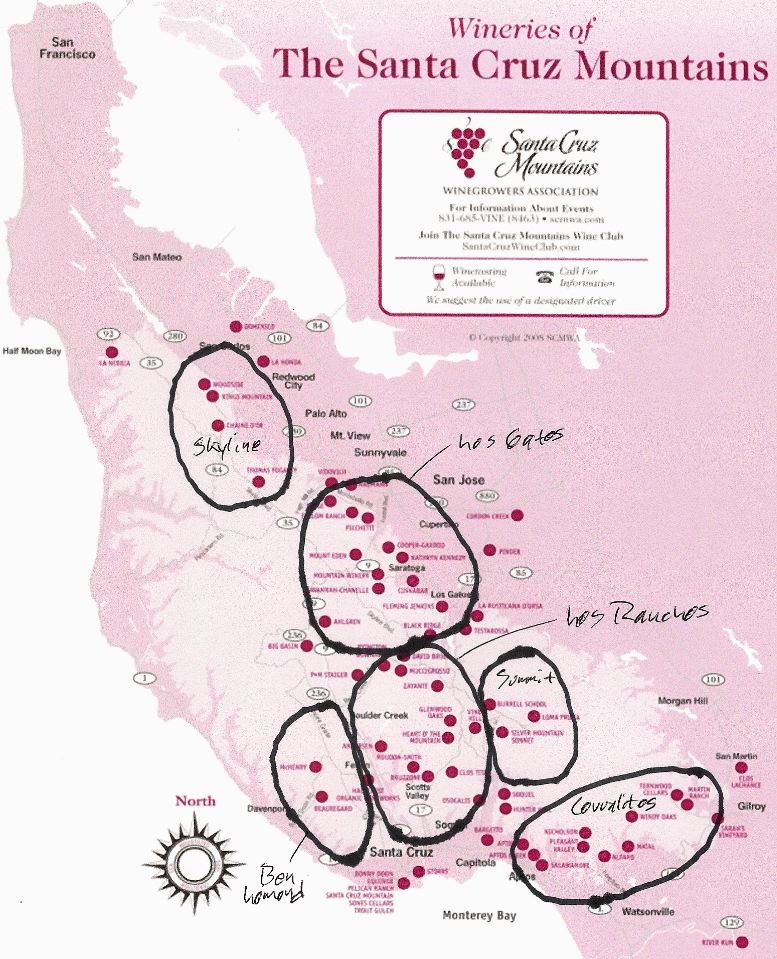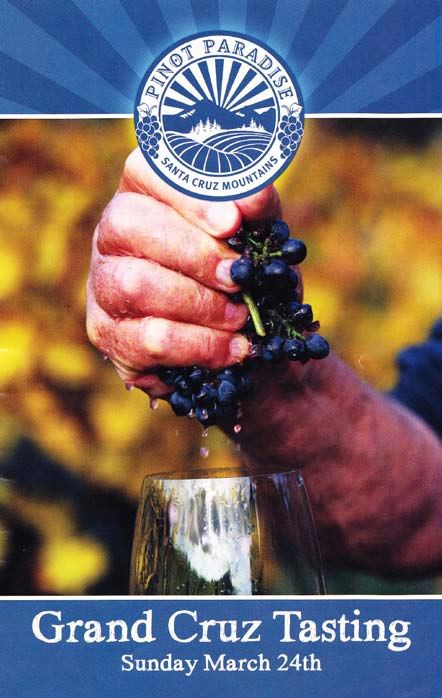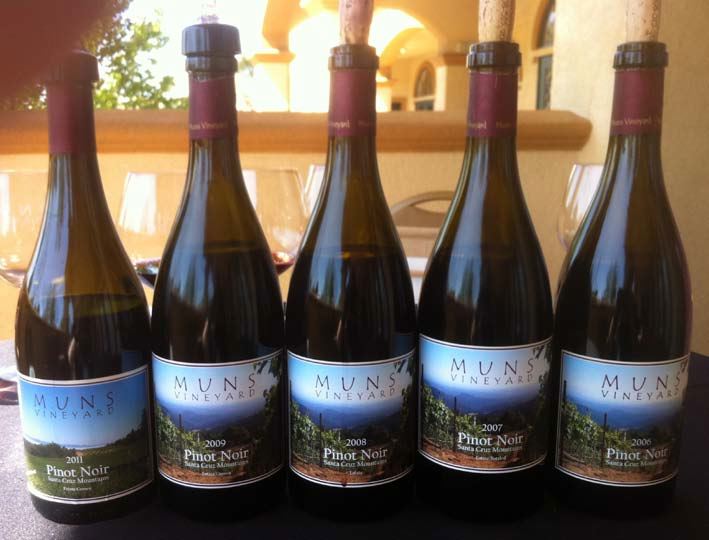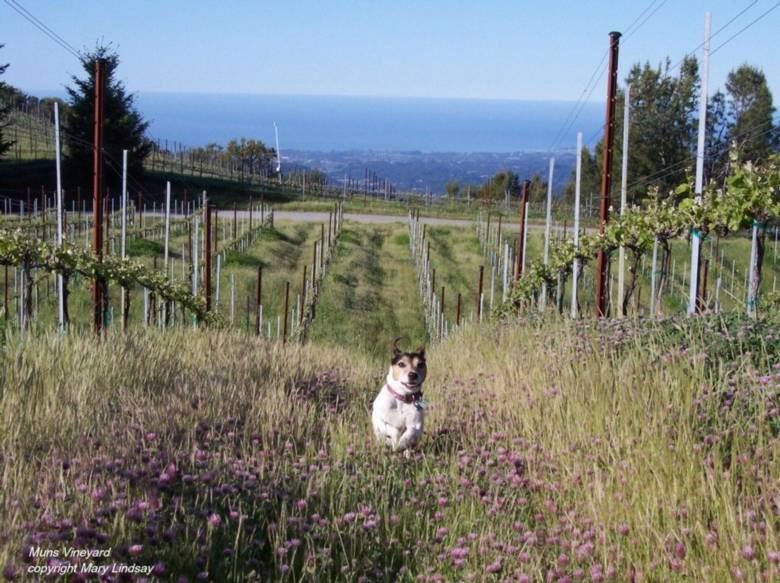Cruzin’ the Pinot Trail: Pinot Paradise in the Santa Cruz Mountains
There is no other wine region even remotely like the Santa Cruz Mountains. It is one of the cradles of Pinot
Noir in California, but is better known for its eccentric and Bohemian residents than its viticultural heritage. The
reasons for this are evident when you cruz throughly the hilly, heavily wooded landscape. Unlike every other
major winegrowing region in California, wineries and vineyards are not visible from major highways and roads.
Vineyard sites are often in rugged, remote areas, tucked into a nook or cranny among the heavily forested
countryside or perched on a hilltop accessible only by a length and precariously narrow road. Guideposts and
signage directing visitors to wineries is nonexistent and locals quickly remove even the smallest roadside
placard. Roads often zigzag and traversing them is agonizingly slow. Speaking of zigzag, the low-key
residents of the Santa Cruz Mountains often have more interest in the crop you can smoke than the one you
can drink.
The Santa Cruz Mountains American Viticultural Appellation (AVA) was federally approved in 1981, and was
one of the first AVAs to be defined by geophysical, altitudinal and climatic factors. The eastern and western
boundaries are defined by elevation, namely mountainous land above 400 feet on the western side and from
400 to 800 feet on the eastern side. The squiggly outline of the Santa Cruz Mountains AVA reflects the fog line
that surrounds the mountains.
This large appellation stretches over 408,000 acres incorporating parts of three counties: Santa Cruz County to
the west, Santa Clara County to the east, and San Mateo County to the north. It can easily take two hours
(about 100 miles) to drive from one end of the AVA to the other. The Santa Cruz Mountains AVA is not included
in the Central Coast AVA (but part of Santa Cruz County is).
There are many small family owned vineyards (over 200) and wineries (90+), and the total vineyard acreage
reported by the Santa Cruz Mountains Winegrowers Association is roughly 1500 acres divided evenly among
Pinot Noir, Cabernet Sauvignon, Chardonnay and other varieties such as Merlot and Zinfandel. (Exact, up-to-date
figures for vineyard acreage, number of vineyards and wineries is unavailable in keeping with the laid
back vibe in this region. Previous research done by me a few years ago indicated 600+ acres of Pinot Noir).
A single vineyard in some California appellations have as much if not more acreage than the Santa Cruz
Mountains has in its entire AVA. The largest commercial vineyards are between 40 and 60 acres. As you can
imagine, wine grapes are a scarce commodity and in considerable demand.
There are a myriad of microclimates in the Santa Cruz Mountains, but wine grapes are planted in three general
climates: (1) coastal vineyards are typically at lower elevations with fog burning off late in the morning, (2) high
mountain and summit vineyards are above the fog, (3) valley slopes on the eastern side of the mountains along
the peninsula which are warmer. The AVA has been further divided into six sub-regions according to flavor
profiles. One of the six, Ben Lomond Mountain is a true sub-AVA of the Santa Cruz Mountains. The other five
are Saratoga/Los Gatos, Summit Road, The Coastal Foothills (Los Ranchos), and Corralitos/Pleasant Valley. For more
information visit www.appellationamerica.com/wine-review/645/Renaissance-Grape.html. An approximation of
the sub-regions is illustrated below.

Since the Santa Cruz Mountains are relatively isolated and have no large corporate involvement, they wines
have retained a charming innocence and purity, seemingly unaffected by the trends that drive the sales of large
wine producers. The wines are characterized by an earthy, mineral quality, complex and intense flavors, and
balanced acidity that allows them to age well. There are few vestiges of the style of Pinot Noirs of the 1970s
and 1980s when many Santa Cruz Mountains Pinot Noirs were rustic, chunky and tannic, and often poorly
crafted. Today, the Pinot Noirs, led by producers such as Alfaro Family Vineyards & Winery, Big Basin
Vineyards, Mount Eden and Domaine Eden, Rhys Vineyards, Windy Oaks Vineyards & Winery, Thomas
Fogarty Winery and Varner & Neely, are thoroughly modern in style with commendable value-to-price ratios.
A major reason for the modernization of Pinot Noir from this region is due to the widespread use of current
viticultural know how. A number of experienced vineyard consultants, including Prudy Foxx and Greg Stokes,
are actively assisting clients in choosing appropriate sites and aspects, planting the proper rootstocks and
clones to match the sites, overseeing proper trellising, canopy management, and emphasizing sustainable
vineyard practices. The result has been a notable improvement in wine quality.
This quote from the book, Sideways, seems to be referring to Santa Cruz Mountains Pinot Noir. “It’s a hard
grape to grow....it’s thin-skinned, temperamental, ripens early....it’s not a survivor like Cabernet, which grow
anywhere and thrive even when it’s neglected. No, Pinot needs constant care and attention....it can only grow
in these really specific, little, tucked-away corners of the world.”
One of the challenges of the organizers of Pinot Paradise is to enlist more participation by Santa Cruz
Mountains Winegrowers Association (SCMWA) members. There is an apparent lack of cohesiveness among
winery members. Of the 80 wineries listed in the latest SCMWA brochure, only 35 participated in the Grand
Cruz Tasting held on Sunday, March 24. Prominent members who were absent included Bonny Doon
Vineyard, Clos de la Tech, David Bruce Winery, Loma Prieta, McHenry Vineyard, Rhys Vineyards, Salamandre
Wine Cellars,Testarossa, and Windy Oaks Estate. Well-regard Pinot Noir producers Neely and Varner are not
listed as members of SCMWA and did not participate.
I attended the Pinot Paradise Technical Session on “Minerality - Taste and Terroir” held at the historic Mountain
Winery in Saratoga. This was originally Paul Masson’s winery named La Cresta, that was completed in 1905.
It was destroyed by the San Francisco earthquake a year later, but by 1907 a new winery stood in its place.
Masson became quite successful until Prohibition intervened. By the time of Repeal in 1933, Masson, now a
widower (he was married to noted vintner Charles Lefranc’s daughter, Louise), had lost most of his fortune and
in 1936 sold his winery to Martin Ray. Since then the ownership of the property has changed hands numerous
times. In 1958, an amphitheater was built on the grounds and The Mountain Winery became known for its
Summer Concert Series. The current owners of The Mountain Winery have dedicated themselves to protecting
the natural beauty of the estate. Many events and weddings are now held at the venue. The Mountain Winery
also produces Pinot Noir and Chardonnay from estate grapes under the direction of winegrower Jeffrey
Patterson of Mount Eden.
The moderator of the “Minerality- Taste and Terroir” seminar was David Glancy, a wine educator and founder of
the San Francisco Wine School. Panel winemakers included Duncan Meyers of Arnot-Roberts Winery, Bradley
Brown of Big Basin Vineyards, Nathan Kandler of Thomas Fogarty Winery & Vineyards and Jim Schultze of
Windy Oaks Estate Vineyards & Winery. Each of the panelists presented a wine intended to show minerality. It
is always challenging to attempt to taste wine while a seminar is in progress, but for me, although all wines
showed bright acidity, the Thomas Fogarty wine was the only wine to reveal minerality.
2012 Arnot-Roberts Legan Vineyard Barrel Sample Santa Cruz Mountains Pinot Noir
Vineyard nonirrigated,
planted in the 1980s at a cold, windy location at 1,500 feet elevation in the Corralitos sub-region.
Well-drained sandy loam soils with considerable fine crushed rock. Site shows hi acidity and low fruit
transparency. Yield 1.5 tons per acre. 100% whole cluster, foot crushing, ambient yeast fermentation, aged in
5-year-old French oak barrels. Low sulfur levels.
·
Nose has a confected, carbonic character. Flavors veer to
dark red and purple fruits with mild tannins and nervy acidity.
2010 Big Basin Vineyards Woodruff Family Vineyard Santa Cruz Mountains Pinot Noir
A dry-farmed
vineyard located in the Corralitos sub-region, planted over 30 years ago. Elevation is 400 feet. Soils are
sandy loam. 25% whole cluster, aged 15 months in primarily transparent French oak barrels.
·
Deep reddishpurple
color in the glass. Aromas of dark berries with a slight green note. Flavors of blackberries and plum
with a hint of tarry oak in the background. Bright acidity. Delicate finish that has some length. Good.
2010 Thomas Fogarty Winery & Vineyards Windy Hill Vineyard Estate Santa Cruz Mountains Pinot Noir
A hilltop vineyard in the skyline sub-region at 2,000 feet that is cool and rocky. Soils are fractured sandstone.
A challenging site for ripeness. Yields less than 1 ton per acre. Last bottling from original plantings which are
Martini and Bruce selections. New plantings have closer spacing with a different orientation to reduce
exposure to the brutal winds. 100% whole cluster, ambient yeast fermentation, aged in once-used French oak
barrels. No sulfur added after malolactic fermentation. 50 cases.
·
Aromas of fresh purple grapes, spice and
petrichor. Vibrant on the palate with dark berry, spice and grape flavors, clothed in fine-grain tannins with well-integrated
acidity. Exceptional.
2010 Windy Oaks Estate Vineyards & Winery Henry’s Block Santa Cruz Mountains Pinot Noir
Sourced
from estate vineyard’s original plantings, 17th leaf (1996), Wädenswil clone in the Corralitos sub-region. Clay
soils with underlain sandstone, that have low nutrients and lead to low vigor. Very cool, rugged terrain with
significant maritime influence. 50% native yeast, 25% whole cluster, long fermentation of 39 days, over 17
months in barrel. 104 cases.
·
Nicely perfumed with aromas of dark cherries, spice and nutty oak. Moderately
full and rich featuring bright flavors of fresh black cherries with hints of mocha and hazelnut. Very vivid fruit
with an intense, long finish.
Josh Jensen of Calera Wine Company was scheduled to speak on minerality after the panel presentation, but
illness prevented him from attending. His winemaker, Mike Waller filled in and presented three wines. Waller
noted that because of the large percentage of whole cluster in Calera wines, the added potassium elevates the
pH and acid must be added. The Calera wines definitely showed minerality.
2009 Calera Ryan Vineyard Mt. Harlan Pinot Noir
14.1% alc.. 2500 feet elevation. Aged 18 months in 30%
new French oak barrels.
·
Lovely aromas of fresh cherries, rose petals and spice. Earthy, with flavors of black
cherries and dark berries. The muscular, chalky tannins stand out. Good
2009 Calera Selleck Vineyard Mt. Harlan Pinot Noir
14.1% alc.. Aged 17 months in 30% new French oak
barrels.
·
A more serious wine of tremendous interest. Aromas of cherries, blueberries, sandalwood, spice and
sandstone. Delicious middleweight flavors of dark cherries and berries. Very smooth on the palate with less
bitter tannins than the Ryan and more depth and length on the finish. Exceptional.
NV Calera Mt. Harlan Chardonnay
2200 feet elevation. Native yeast fermentation, aged 10 months in 30%
new French oak barrels.
·
This wine is less about fruit and more about acidity and salinity. Flavors of lemon,
white peach and roasted nuts. Impressive balance. Very good.
The Grand Cruz Tasting was held in Campbell at the Villa Regusa event center. Each year participating
wineries offer a 3.0 L bottle for a silent auction to raise money to support SCMWA. In addition, a cuvée of
vintages 2007 through 2011 of 36 Santa Cruz Mountains wineries was offered at auction. SCMWA president
Dave Moulton of Burrell School Winery is shown holding the cuvée.
Before opening to the public, a pre-tasting was available to members of the press and trade and I was able to
sample a number of wines from the 35 participating wineries. Here are the wines at the Grand Cruz Tasting
that caught my fancy with brief tasting impressions.

I tasted a mini-vertical of Pinot Noirs from Muns Vineyard. Ed Muns farms a 13-acre vineyard that is the
highest in the Santa Cruz Mountains at 2,600 feet. Soils vary from rich loam to shale to red clay. Planting
occurred from 1998 to 2005 with Dijon clones 114, 115, 667 and 777. Farming is sustainable and impeccable.
90% of production is sold to prominent producers including Beauregard Vineyards, Silver Mountain Vineyards,
Sonnet, Soquel Vineyards and Thomas Fogarty. The Muns Vineyard wines were first produced in 2003 and
are crafted by owner Ed Muns and winemaker Tony Craig. All the wines are 100% de-stemmed, whole berry
fermented, aged in Hungarian oak barrels and are unfined and unfiltered. Common threads in the wines are
red cherry fruit, bright acidity and firm tannins. Ed predicted the 2012 vintage will be terrific as there was no
rain, harvest occurred on schedule, and the grape chemistries were perfect.
2006 Muns Vineyard Santa Cruz Mountains Pinot Noir
13.9% alc., pH 3.47, TA 0.66, 380 cases, $40. Aged
17 months in 33% new Hungarian oak barrels.
·
Very savory nose showing aromas of dried herbs and red
cherry. Has held its age well with good vibrancy, offering light weight flavors of red cherries, nutmeg spice and
savory herbs. Good.
2007 Muns Vineyard Santa Cruz Mountains Pinot Noir
14.5% alc., pH 3.50, TA 0.81, 380 cases, $40. Aged
17 months in 33% new Hungarian oak barrels with lees stirring.
·
Deeper, reddish-purple color. A gregarious
wine with a very ripe fruit nose and rich flavors of dark cherries and sassafras. Robust with firm, but balanced
tannins. Good.
2008 Muns Vineyard Santa Cruz Mountains Pinot Noir
14.6% alc., pH 3.51, TA 0.91, 165 cases, $40. Aged
17 months in 30% new Hungarian oak barrels with lees stirring.
·
Appealing aromas of delicate red fruits, savory
herbs and vanillin oak. Middleweight flavors of juicy black cherries with an enticing accent of brown spices
including cinnamon and a slight mocha note. Refreshing cut of acidity on the finish. Very good.
2009 Muns Vineyard Santa Cruz Mountains Pinot Noir
14.1% alc., pH 3.52, TA 0.74, 242 cases, $40.
Released November 2012. Ideal growing conditions this vintage with yields of 3 tons per acre. Aged 17
months in 33% new Hungarian oak barrels with lees stirring.
·
Pleasing aromas of black cherries, red plums and
roasted nuts. Delicious mid-weight flavors of dark stone fruits with a subtle riff of spice. The tannins and
acidity are nicely balanced and this wine drinks seamlessly. My favorite. Exceptional.
2010 Muns Vineyard Santa Cruz Mountains Pinot Noir Unreleased, not reviewed.
2011 Muns Vineyard Santa Cruz Mountains Pinot Noir
80 cases, $40. Released November 2012. Two
versions of Muns Vineyard Pinot Noir were made in 2011: one is the usual style crafted by Tony Craig and the
other (tasted here) was made by winemaker Ryan Beauregard using native yeast and aged 8 months in
second use American oak barrels.
·
Wild and exotic on the nose featuring delicate red cherry fruit and a hint of
volatile acidity. Slightly confected red cherry flavor with hi-tone acidity and soft tannins. For the adventurous.
Decent.

2010 Alfaro Family Vineyards Alfaro Family Estate Vineyard Santa Cruz Mountains Pinot Noir
13.5%
alc., 188 cases, $35. Aged 17 months in 50% new French oak barrels.
·
An impressive wine with attentiongrabbing
black cherry and spice flavors, supple tannins, and a finishing presence that keeps returning for an
encore. Still showing significant oak imprint at this young age but this will improve over time. A tremendous
value and one of my favorites at the Grand Cruz Tasting. Very good.
2009 Big Basin Vineyards Lester Family Vineyard Santa Cruz Mountains Pinot Noir
14.1% alc., 193
cases, $44. 15% whole cluster. Aged 16 months in 50% new French oak barrels. Unfined and unfiltered.
·
Deep, dark reddish-purple color in the glass. Aromas of blackberry jam and plum cake with a touch of oak.
Full-bodied and plush, with intensely flavorful blackberry and black plum fruit backed by firm tannins and
complimentary oak. Impressive concentration but not excessively weighty. Very good.
2009 Burrell School Vineyards “Principal’s Choice” Estate Reserve Pinot Noir
14.4% alc., pH 3.3, TA
0.72, 340 cases, $45. Aged 18 months in 80% new French oak.
·
There is a very appealing core of luscious
dark fruit with a vivid acid spine, but the fruit is buried in oak. Good. The 2010 vintage was also offered and is
more to my liking with apparently less new oak. This wine shows less ripeness, is more red cherry-driven with
spot-on vibrancy. Very good.
2011 Cinnabar Santa Cruz Mountains Pinot Noir
13.5% alc., pH 3.65, TA 0.61, 125 cases, $N/A. Sourced
from Pleasant Valley vineyards. Aged 11 months in 40% new French oak barrels.
·
Very up front drinker, light in
weight but flavorful with bright cherry flavors underlain with nutmeg and cinnamon spice. Impressive for this
vintage. Very good.
2010 Clos Tita Estate Santa Cruz Mountains Pinot Noir
14.5% alc., pH 3.9, TA 0.6, <100 cases, $36.
Clones 15, 777, 113 and 114. 15% whole cluster. Aged 23 months in 50% new French oak barrels.
·
This wine
was a stand out among all those tasted at the Grand Cruz Tasting. Amazing dark fruit purity that attacks the
mid palate with a vengeance, coats every nook and cranny in the mouth, and leaves a lasting impression. Still
sporting muscular tannins and will benefit from more bottle age, but this is a knock out, especially at this
modest price. Exceptional.
2010 Domaine Eden Santa Cruz Mountains Pinot Noir
pH 3.30, TA 0.81, 1,537 cases, $35. Harvested at
23.9º Brix. Clones 828, Calera, Mt Eden, Swan, 667 and 777. Aged 12 months in 50% new French oak.
·
A
forward drinking wine offering tart, red cherry flavor with bright acidity. Decent.
2010 Mount Eden Estate Santa Cruz Mountains Pinot Noir
pH 3.45, TA 0.85, 804 cases, $N/A. Harvested
at 23.5º Brix. Aged in 70% new French oak barrels.
·
One of the flagship wines of the Santa Cruz Mountains
AVA. A connoisseur’s wine with class and sophistication. Still young, but showing vivid red fruits with good
concentration, lively acidity, and a polished, focused finish that displays the electricity associated with
minerality. Beautiful integration of oak. Exceptional.
Pleasant Valley Vineyards Winemaker Craig Handley was pouring three Pinot Noirs from Lester Family
Vineyards in Corralitos, about a miles from his winery. Soils are sandy. 100% de-stemmed, whole berry,
fermented in small lots. Aged in 50% new and 50% 1-year-old French oak barrels.
2012 Sante Arcangeli Family Wines Barrel Sample.
Sourced from a Corralitos vineyard. Very few 2012
samples were available for tasting at the Grand Cruz Tasting but this one really stood out. Aged in 70% new
French oak barrels and still showing significant espresso oak topcoat, the fruit is nevertheless stunning. I was
less impressed with the challenging 2011 vintage of this wine which was much more austere.
For information on the wineries of the Santa Cruz Mountains, visit SCMWA at www.scmwa.com or phone
831-685-8463. For information on the vineyards of the Santa Cruz Mountains, visit the Viticulture Association
of the Santa Cruz Mountains (VASCM) at www.vascm.org.
For extensive information on the Santa Cruz Mountains winegrowing region also visit the PinotFile at
www.princeofpinot.com and enter “Santa Cruz Mountains” under the Google search feature.
Santa Cruz Mountains Passport Day will be Saturday, April 20, 2013, presented by SCMWA.
Santa Cruz Mountains Vintner’s Marketplace will be held at Santana Row in San Jose, California on April 21,
2013. Similar to a farmer’s market, this event allows you to sample and buy wines from the Santa Cruz
Mountains. Over 20 Santa Cruz Mountains wineries will participate, including Beauregard Vineyards, Burrell
School Vineyards, Muns Vineyard, Silver Mountain, Storrs Winery and Windy Oaks Estate. Admission will be
free but wine tasting requires purchase of tickets. Visit www.scmwa.com for information. Oops, the event is
sold out!
Santa Cruz Mountains Vintners’ Festival will be June 1-2 and 8-9, 2013. The first weekend features wineries of
Santa Clara and San Mateo counties and the second weekend wineries of Santa Cruz County. Tickets are
now available at www.scmwa.com.
A good source of Santa Cruz Mountains wines is the wine bar and retailer, Vinocruz, located at 725 Front St.,
#101, in Santa Cruz. Visit www.vinocruz.com.








